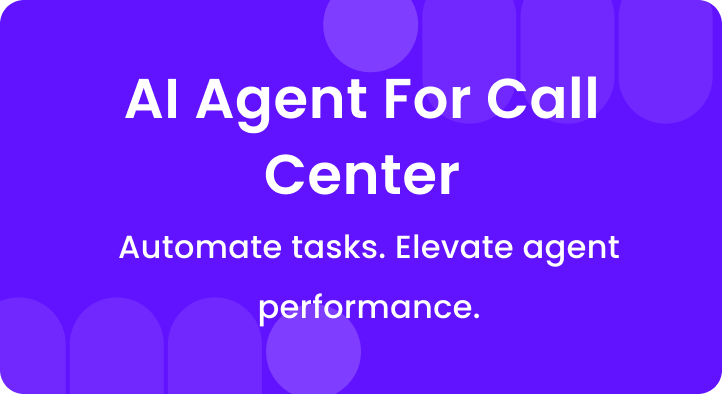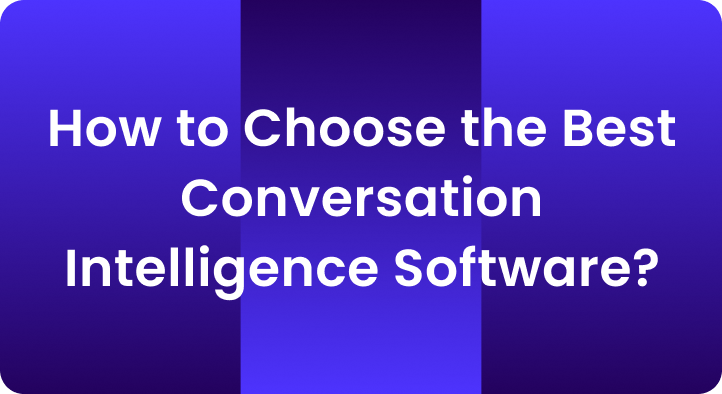You know that awkward pause when a customer says, “Can I speak to your manager?” Yeah, that’s call escalation.
It usually means something went sideways.
Maybe the agent didn’t have the right info. Maybe the caller was already mad before the phone even rang. Or maybe, just maybe, your call center isn’t handling escalations the smart way.
In contact centers, escalations aren’t just annoying—they’re expensive. They eat up time, frustrate managers, and wreck customer satisfaction scores.
So, how do you cut them down without burning out your agents or ticking off your callers?
In this article, we’ll unpack everything you need to know about call escalations—from what they are, why they happen, and how to reduce them before they blow up.
Table of Contents
A. What Is Call Escalation?
Call escalation happens when a frontline agent can’t fully handle a customer’s issue, so the call gets passed to someone higher up—like a supervisor or a manager.
Sounds simple, right? But it’s not always that straightforward.
Escalations usually mean the customer is already frustrated. And once a call gets escalated, it takes more time, more people, and more effort to fix the issue.
Real-world examples:
- A customer calls to dispute a charge. The agent follows the script, but the caller keeps saying, “You’re not helping—I need your manager.”
- A loan applicant is denied and demands an explanation beyond what the agent is allowed to share.
- A glitch in a payment system causes panic, and the customer won’t settle for anything less than a supervisor.
In all of these cases, the agent hit a wall. And unless your team is trained and supported the right way, these escalations will keep happening.
B. What is escalation metrix?
Escalation Metrix (yep, with an ‘x’ because it’s cooler that way) is how contact centers track, measure, and analyze escalated calls.
Think of it like a report card for customer frustration. It tells you:
- How many calls are getting escalated
- Which agents have higher escalation rates
- What types of issues cause the most escalations
- How long it takes to resolve an escalated call
Why it matters:
You can’t fix what you don’t measure.
Escalation Metrix helps you spot patterns, find weak spots in your process, and coach agents before the next call blows up.
For example, if Agent A has twice as many escalations as Agent B, maybe they need better training—or maybe they keep getting stuck with the worst calls.
The Metrix helps you figure that out.
Platforms like Enthu.AI make it easy by tagging escalations.
You don’t have to listen to every call manually. Just filter by escalation tag, and boom—you see where the fire’s starting.
Call Escalation Rate Formula:
Escalation Rate (%) = (Number of Escalated Calls / Total Calls Handled) × 100
C. Why calls get escalated: 7 common triggers
Let’s face it—no contact center wants to deal with escalated calls. They’re stressful, time-consuming, and costly.
In fact, research from SQM Group shows that escalated calls cost 2X more to resolve than standard ones.
And that’s just the direct cost—add customer churn, agent burnout, and bad CSAT, and you’ve got yourself a mess.
But here’s the kicker: most escalations are preventable. If you know what’s triggering them, you can fix them at the root.
Here’s an Escalation Trigger Matrix that breaks down the most common reasons why calls get escalated, along with real phrases customers use and the risk level for each:
| Trigger | Example Phrase | Escalation Risk |
| Agent lacks knowledge | “You don’t seem to understand my issue.” | High |
| Policy restriction | “Why can’t you just make an exception?” | Medium-High |
| Long hold times | “I’ve been waiting forever. Let me talk to someone else!” | Medium |
| Poor agent tone | “Why are you being rude?” | High |
| Repeated contacts | “This is my third time calling!” | Medium |
| Billing or money issue | “You charged me twice. This is unacceptable.” | High |
| Emotional distress | “I’m seriously upset right now.” | Medium-High |
Escalations aren’t random—they follow patterns.
Here’s a breakdown for each one so you can spot the red flags early and fix what’s broken.
1. Agent lacks knowledge
Trigger phrase: “You don’t seem to understand my issue.”
This one hits hard.
When an agent fumbles through answers or sounds unsure, it erodes confidence instantly.
The customer thinks: “Okay, this person clearly can’t help me—get me someone who can.”
And just like that, you’ve got an escalation.
According to Salesforce, 78% of customers will switch to a competitor after multiple poor experiences—and one clueless call is enough to plant the seed.
Fix it with: Micro-coaching sessions on weak topics, Enthu.AI tagging to find knowledge gaps, and building a searchable internal knowledge base.
2. Policy restriction
Trigger phrase: “Why can’t you just make an exception?”
Policies are necessary—but when they sound robotic or inflexible, customers feel like they’re talking to a wall.
It’s not the what, it’s the how you say it that leads to an escalation.
Fix it with: Agent empowerment (within reason), and scripting that balances empathy with clarity. Let agents sound human, not corporate.
Customers don’t Google “inflexible agent responses”—they search “how to avoid escalation in the call center due to policy limits”—and this trigger hits right there.
3. Long hold times
rigger phrase: “I’ve been waiting forever. Let me talk to someone else!”
This one’s a silent killer. Even if your agent is a rockstar, if the customer has waited 8+ minutes listening to flute music, they’re walking in angry.
Escalation becomes the default move—not a last resort.
A study by Velaro shows that 60% of customers hang up after being on hold for just one minute. Now imagine how many stay—but ask to speak to a supervisor instead.
Fix it with: Hold time tracking, Enthu.AI silence tagging, and coaching agents to keep customers in the loop during delays. A little update goes a long way.
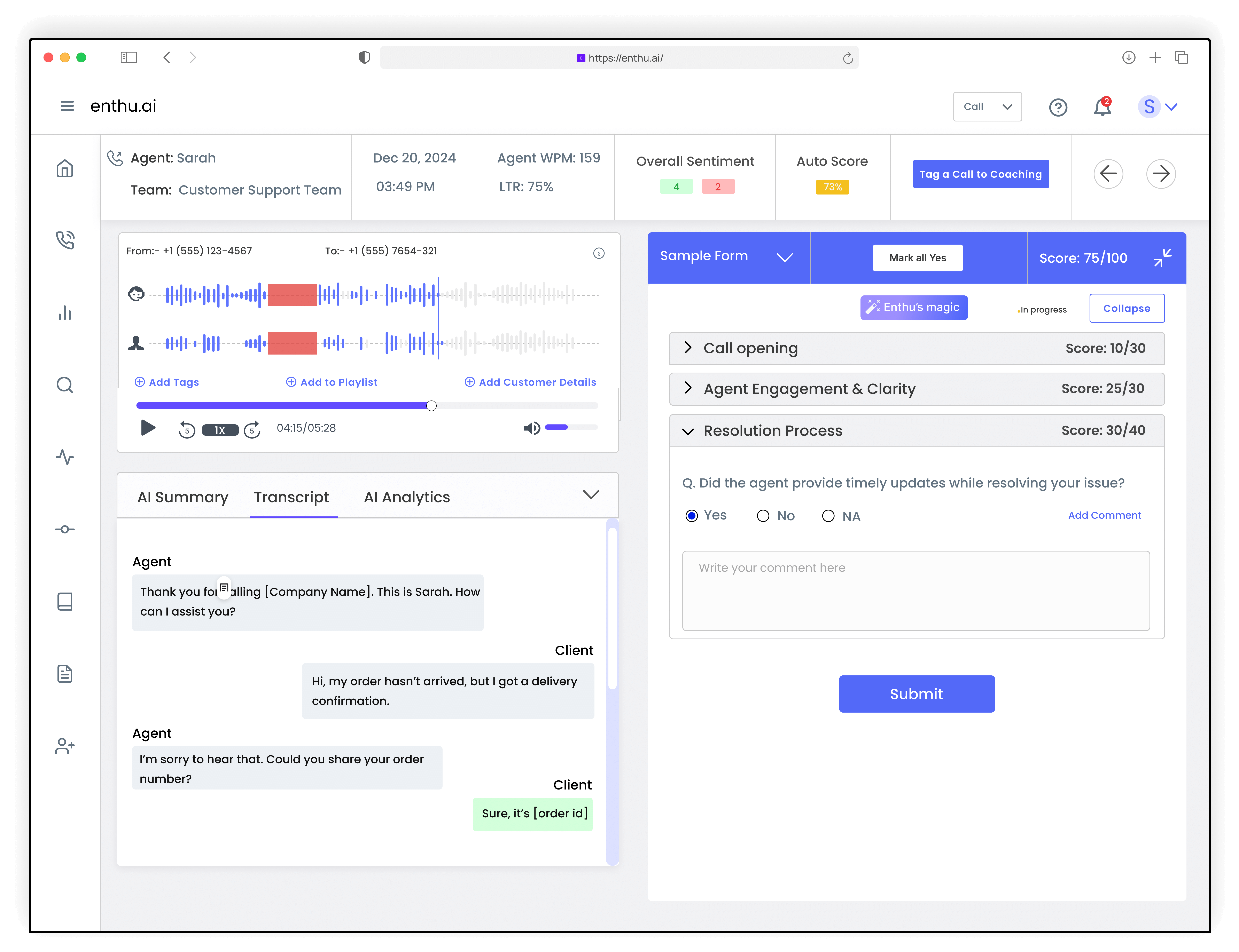
4. Poor agent tone
Trigger phrase: “Why are you being rude?”
You can say the right words in the wrong tone and lose the whole call. Tone reflects empathy, patience, and confidence—or the lack of it.
Fix it with: Emotion detection tools help you find tone issues quickly. Use real call examples in coaching to drive the point home.
5. Repeated Contacts
Trigger phrase: “This is my third time calling!”
If a customer has to call three times for the same issue, their frustration is baked in. By the third attempt, they want escalation—not resolution.
Fix it with: First call resolution (FCR) focus. Track repeat contact tags and coach agents on closing loops properly.
6. Billing or Money Issue
Trigger phrase: “You charged me twice. This is unacceptable.”
Touch someone’s money and watch emotions spike. Billing issues are one of the fastest ways to get a call escalated—especially if the agent sounds unsure or defensive.
Stat alert: According to Accenture, 89% of customers feel frustrated when they need to repeat issues involving billing or payments. And frustration = escalation.
Fix it with: Tight scripting, clear refund guidelines, and role-play training for billing scenarios.
7. Emotional Distress
Trigger phrase: “I’m seriously upset right now.”
These are high-risk calls. The customer may be angry, anxious, or overwhelmed—and a wrong move here can make things explode.
Fix it with: Empathy-first language, pausing when needed, and tracking sentiment with Enthu.AI to refine de-escalation playbooks.
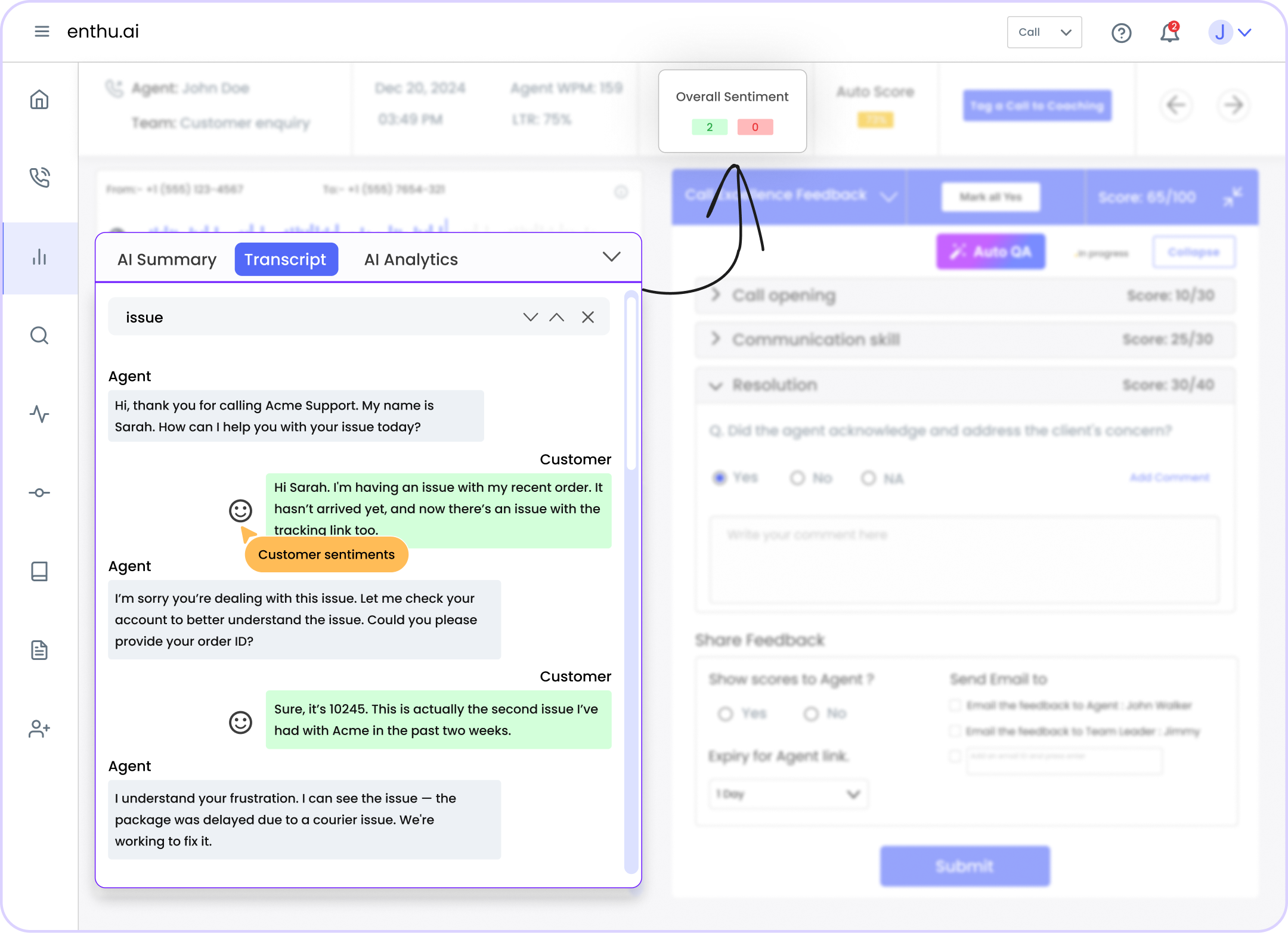
D. 5 Ways to Reduce Call Escalations Proactively
QA can lead the charge here—no more playing defense.
Call escalations aren’t just a support team problem—they’re a quality issue too.
And if you’re serious about fixing them, you’ve got to stop reacting and start predicting.
The good news? Escalations leave behind a breadcrumb trail—and QA is in the perfect position to follow it.
Here are five practical, QA-led strategies to prevent escalations before they happen:
1. Identify trigger patterns with call tagging
Start by tagging every escalation-type call by trigger category—whether it’s lack of product knowledge, billing disputes, or agent tone.
With tools like Enthu.AI, you don’t need to sift through endless call recordings. The platform highlights calls based on phrases, sentiment, and behavior—making it easy to spot patterns.
Pro tip: Run weekly reports to see which triggers are spiking. That’s your next coaching opportunity.
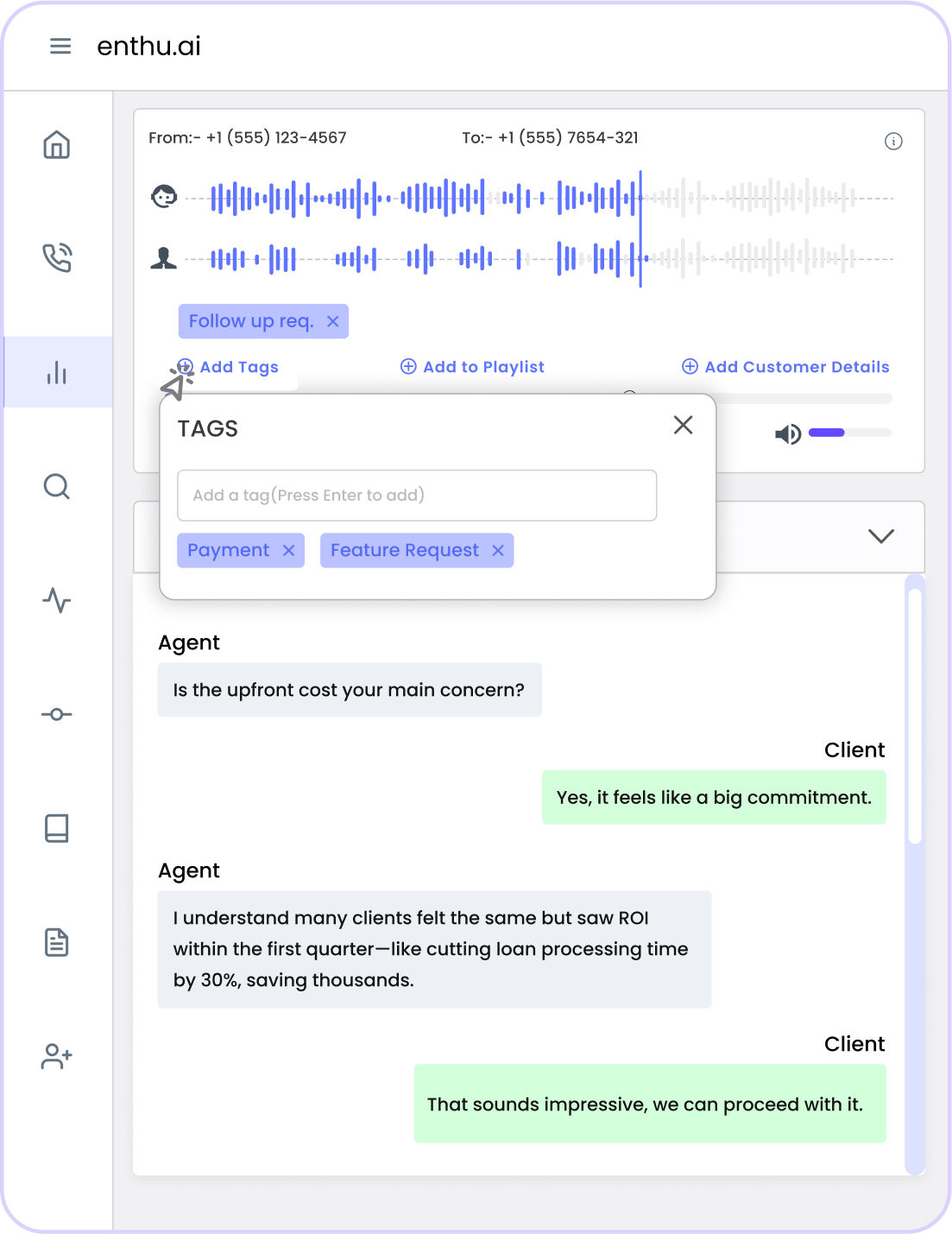
2. Coach on real calls (not hypotheticals)
Generic coaching doesn’t work.
If an agent triggered an escalation by saying, “It’s not my department,” don’t coach them on generic objection handling—coach them on that exact moment.
Use Enthu.AI to bookmark escalation triggers inside the call and build targeted, bite-sized coaching sessions around them.
Why it works: Agents learn faster when they hear themselves and understand the exact moment where things went wrong.
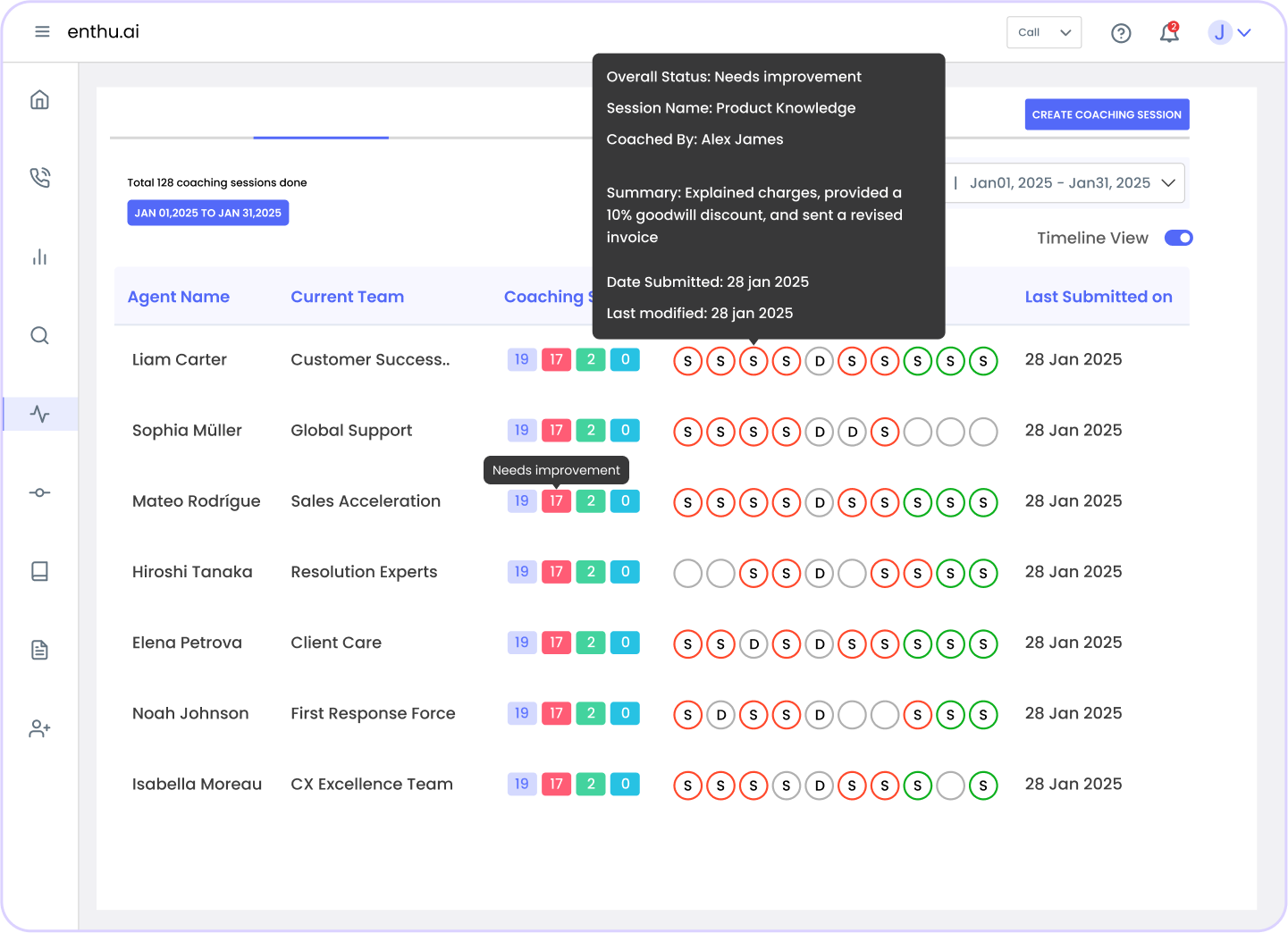
3. Spot & fix repeat offenders early
Every contact center has escalation-prone agents—not because they’re incapable, but because they’re often undertrained or overwhelmed.
QA teams should flag agents who get repeated escalations and intervene early with 1:1 support.
Speech analytics gives you agent-wise escalation trend reports so you can track improvement or regression over time.
4. Preload high-risk scenarios into training
Certain scenarios—like billing disputes, cancellations, or angry customer rants—carry a higher escalation risk if mishandled.
QA should develop a library of high-risk scenarios and integrate them into agent onboarding and ongoing training programs.
According to ICMI, 62% of contact centers say that scenario-based training significantly improves conflict resolution outcomes.
5. Close the feedback loop fast
Escalations happen when agents don’t realize they’re doing something wrong.
Feedback that arrives three weeks late doesn’t help anyone.
QA should shift from end-of-month evaluations to quicker interventions.
With Enthu.AI, you can set up alerts that notify team leads when an escalation-triggering phrase appears—so agents get coached within hours, not weeks.
Result: Faster course correction, fewer repeat mistakes, and better customer outcomes.
Use QA Scorecards to Catch Escalations Early
A good QA scorecard does more than check boxes—it helps catch escalation triggers before they blow up.
By scoring behaviors like ownership, empathy, and use of negative phrases, QA teams can spot risk patterns early.
Want to build a scorecard that actually reduces escalations?
Check out our QA scorecard guide for examples, templates, and must-track metrics.
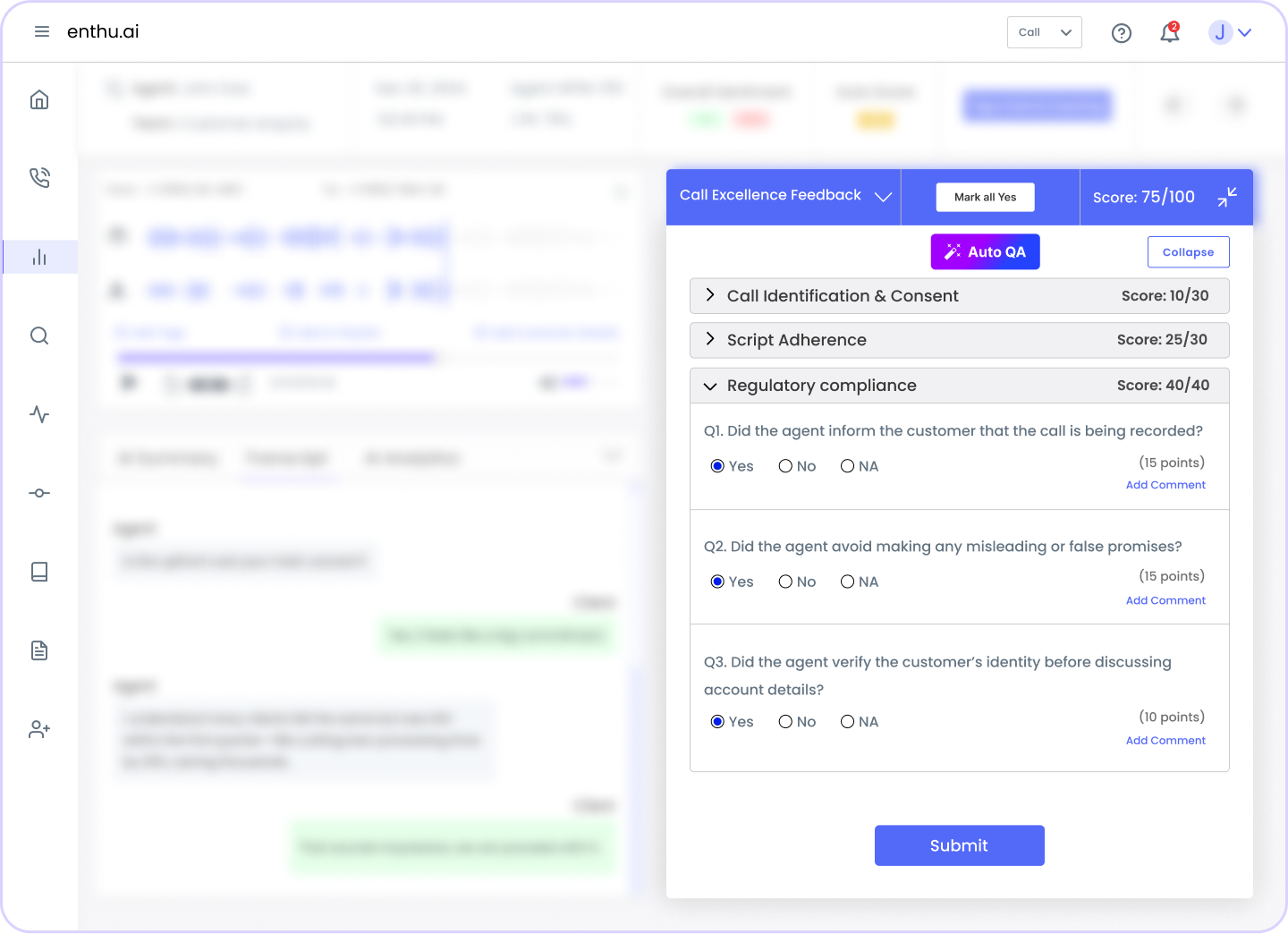
E. How to De-escalate an Angry Customer?
Escalations often happen when agents panic, push back, or simply freeze. But the truth is—most angry customers don’t want to escalate. They just want to be heard, understood, and helped.
Here’s how to help agents calm the storm before it reaches the manager’s desk:
1. Don’t match the energy—lower it
Anger thrives on resistance.
If an agent mirrors a customer’s frustration, the call goes from heated to explosive.
Instead, teach agents to respond in a calm, steady tone—it instantly signals control and professionalism.
Customer: “Why do I have to call five times to fix one issue?” Agent: “I completely understand how frustrating that must be. Let’s work through this together.”2. Acknowledge, then address
Many escalations happen because the agent skips acknowledgment and jumps into solutions.
Train agents to first validate the emotion—even if the customer is wrong.
“I hear how upset you are, and I’d feel the same way in your shoes. Let me fix this for you.”
According to Salesforce, 78% of customers will return to a brand even after a mistake—if they feel heard and valued.
3. Avoid escalation phrases
Some phrases pour fuel on the fire.
Ban these from your scripts:
- “Calm down”
- “That’s our policy”
- “There’s nothing I can do”
- “You’re not understanding me”
Instead, swap them with empathy-driven alternatives like:
- “Let’s look at a solution together”
- “Here’s what I can do for you right now”
4. Empower agents with micro-decisions
Escalations often happen when agents say, “I’m not authorized to…”
Give agents limited decision-making power—like waiving small fees or offering a callback window—so they don’t have to pass the call upward.
Empowered agents = fewer escalations.
5. Use escalated calls as coaching moments
Every de-escalation opportunity is also a coaching opportunity.
Use Enthu.AI to tag and review these calls during QA reviews.
Highlight what worked—and where agents can do better next time.
This creates a culture of continuous improvement, not blame.
Conslusion
Every escalation is a signal — not just of a failed interaction, but of a broken process.
It’s not about blame. It’s about fixing what’s not working.
If escalations are piling up, your QA isn’t just lagging — it’s leaking.
This isn’t the time to wait and watch. It’s the time to act. Audit your calls. Coach like you mean it.
Empower your agents with the insights they actually need. And stop treating escalations as “just part of the job.” They’re not.
The best call centers don’t just react to escalations.
They build systems that prevent them.
Is yours one of them?
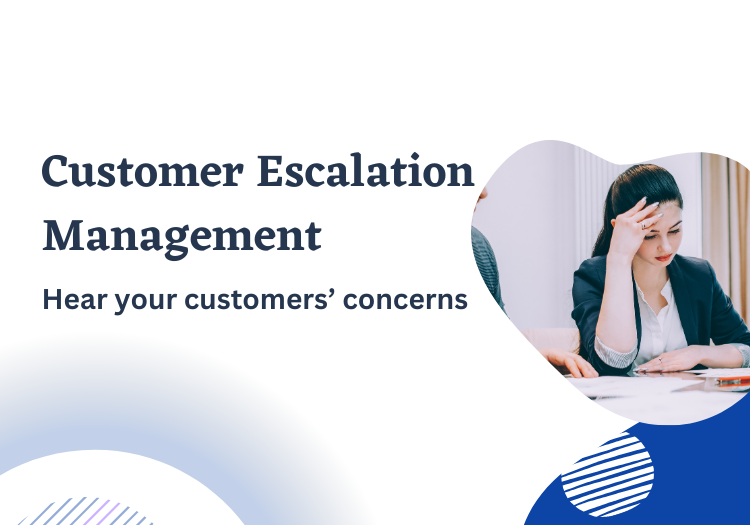
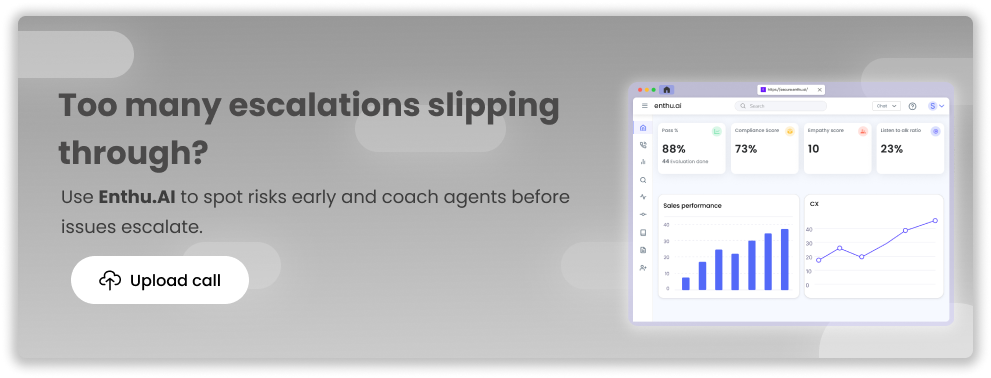

 On this page
On this page

